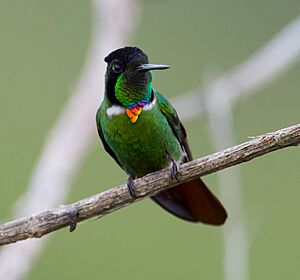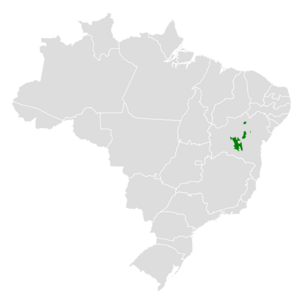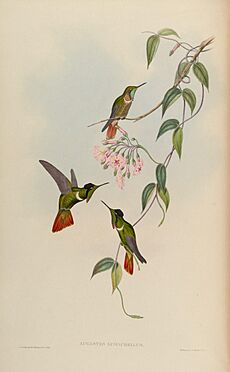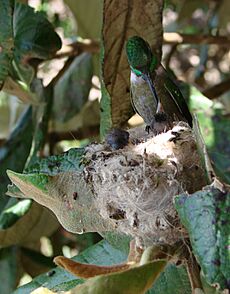Hooded visorbearer facts for kids
Quick facts for kids Hooded visorbearer |
|
|---|---|
 |
|
| Male | |
| Conservation status | |
| Scientific classification | |
| Genus: |
Augastes
|
| Species: |
lumachella
|
 |
|
| Synonyms | |
|
Ornismya lumachella Lesson 1838 |
|
The hooded visorbearer (Augastes lumachella) is a tiny, colorful hummingbird. It lives only in the eastern Brazilian state of Bahia. You can find it high up in the Chapada Diamantina mountains.
This bird is special because males and females look different. Males have shiny, bronzy-green feathers. Their heads are black with a sparkling green throat. Females are more bronzy and less colorful. Both have bright red tails and a white band across their chest. The male's band has a golden-orange spot.
It lives in dry, rocky areas called campo rupestre. These places have poor soil and tough weather. Hooded visorbearers mostly eat nectar from flowers. They also catch small insects. Sadly, this bird is considered near-threatened. This is because its home is shrinking. Mining and farming are big problems for its habitat. Climate change also threatens its future.
Contents
About the Hooded Visorbearer
A scientist named Rene Primevere Lesson first described the hooded visorbearer in 1838. He found a specimen in Bahia, Brazil. He first called it Ornismya lumachella. Later, other scientists moved it into different groups.
In 1849, John Gould created a new group, or genus, called Augastes. He put the hooded visorbearer and another bird, the hyacinth visorbearer, in this group. These two birds are very closely related.
The name Augastes comes from an old Greek word. It means "radiant" or "light-giver." This fits the bird's shiny feathers. The species name lumachella is an Italian word. It means "fire marble," which is a dark stone with sparkly bits. This name likely refers to the bird's shimmering colors.
What Does It Look Like?
The hooded visorbearer is a small bird. It is about 8.3 to 10 centimeters (3.3 to 3.9 inches) long. It weighs about 4 to 4.8 grams (0.14 to 0.17 ounces). Its short beak is black.
Males and females have different looks. This is called sexual dimorphism.
- Males are shiny bronzy-green on their top and bottom parts. Their forehead and throat are a bright golden-green. The sides and top of their head are black. They have a thin black line around their throat patch. A narrow white band crosses their chest. In the middle of this band is a bright golden-orange spot. Their wings are purplish-brown, and their tail is a deep red.
- Females are not as brightly colored. They are more bronzy on their top and bottom. Their head is green, not black. Their face is gray, and the sides of their head are brown. The green on their throat is less shiny than the male's. It also has a stronger bluish-green edge.
Young birds are bronzy-green on top and brown underneath. Their throat is white with green spots. Their tails are coppery-bronze on top and red underneath. They are not as bright as adult birds.
Its Voice
The hooded visorbearer's song is described as "nasal" and "dry." It sounds like "tru tweé tru zee." These short sounds are often repeated many times.
Where It Lives
The hooded visorbearer lives only in eastern Brazil. It is found in the Chapada Diamantina region of Bahia. It lives in a special kind of high-up area called campo rupestre. This area has poor soil, open plants, and rocky places. The weather there can be harsh.
These birds live at heights from 900 to 2,000 meters (about 2,950 to 6,560 feet). They prefer rocky, dry areas. You can find them on mountain tops and flat-topped hills. These places have cactus plants and small shrubs.
Behavior
Feeding Habits
Like all hummingbirds, the hooded visorbearer mostly eats nectar from flowers. But it also eats small insects. It usually looks for food close to the ground, often less than 1 meter (3 feet) high. It is known to visit Vriesea flowers early in the morning. These flowers are usually pollinated by bats, but the birds still find leftover nectar.
Reproduction and Life Cycle
Not much is known about how the hooded visorbearer raises its young. It builds its nest using spines from cactus plants. The nest is usually about 1 meter (just over 3 feet) off the ground.
Protecting the Hooded Visorbearer
For many years in the 1900s, people thought this bird had disappeared. But in 1961, a Brazilian scientist named Augusto Ruschi found them again. He led a trip to an area where they had been seen before.
Today, the International Union for Conservation of Nature says the hooded visorbearer is a near-threatened species. This is mainly because its home range is quite small. Its habitat is shrinking and getting worse. This is due to uncontrolled fires and climate change. Scientists think the bird's home could shrink by as much as 90% by 2060 because of climate change.
Mining for gold, diamonds, and other minerals also harms its habitat. Natural areas are also being turned into pastures for animals and places for people to live. While we don't know exactly how many birds there are, their numbers are thought to be going down.
Hooded Visorbearer and People
The hooded visorbearer is a very popular bird for people who enjoy birdwatching. Many birdwatchers visit the Chapada Diamantina to see it. Special trails have been made in the Chapada Diamantina National Park. These trails help visitors enter the areas where these beautiful birds live.




